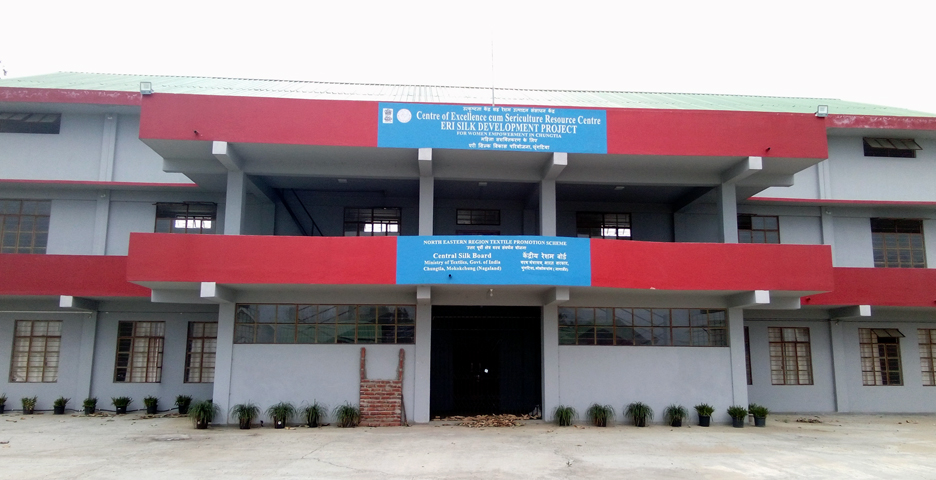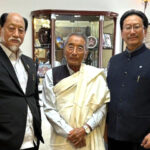Chungtia village in Mokokchung district has the potential to transform into a significant silk production center for Nagaland, through the ambitious Eri Silk Development for Women Empowerment (ESDWE) project.
Spearheaded by the Chungtia Village Council, this project holds the promise of not only boosting economic growth but also empowering local women.

The ESDWE project took root in Chungtia during the fiscal year 2019-20 with Chungtia Village Council acting as the executing agency and was extended till 2021-2022. Facilitating this initiative, the Central Silk Board serves as the implementing agency, with funding support from the Ministry of Textiles, Government of India.
According to data provided to Mokokchung Times by Imotemjen Longkumer, the project nodal officer and consultant of ESDWE, along with Lanusüngzük Longhcar, Secretary of ESDWE, the project has produced approximately more than 80,000 kgs of Pupae, over 10,000 kgs of Eri Cut Cocoon, and more than 8,000 kgs of Raw Silk from June 2020 to April 2024.

The project carries different levels of silk production chain that include covering 300 farmers, tools, equipment, silk development facilities and manufacturing unit of raw materials to refine products. Together with the production, it was said that they have employed about 500 women in the project with 300 farmers, 100 in yarning and spinning, 50 in weaving, 40 in silk rearing and 10 as private reelers.
What beneficiaries say
Tiarenla, who has been rearing Eri silkworms since 2020, stated that she raises about 4000 to 5000 silkworms in cycles and sells their cocoons to a facility. She mentioned earning approximately Rs 40,000 per month from selling both the cocoons and the silkworm pupae (which are commonly consumed across Nagaland). She emphasized that her family’s livelihood depends on sericulture, finding it more beneficial than her previous passion fruit farm.
However, Tiarenla noted challenges in rearing Eri silkworms, particularly during summer when many worms die and also just before entering the cocoon stage. Despite this, she expressed no difficulty in feeding the worms due to the limited involvement of others in Eri farming, allowing them to grow sufficient plants in their farm and neighborhood.
“It is tasking because we have to feed them 24×7 and also continuously remove their excreta. At the same time, taking the worm out of the cocoon is also very tasking. So, we mostly sell them along with the cocoon,” she said.
However, she admitted that it was a very profitable business if the worm do not die, expressing a desire to continue farming in the long term.
“If we don’t sell the worm but cocoon alone, it is not worth it though,” she added.
Tiarenla mentioned that the project mandates providing at least 3 kgs of cocoons to the facility, but her family has successfully sold at least 10 kgs annually.
“I believe that we are trying our best. If lots of other farmers also work hard, I am sure this project will be very successful,” she told Mokokchung Times.
S Amongla, another farmer, mentioned that they had been rearing silkworms before the project but lacked proper facilities. However, with the project providing all required facilities, from silkworm trays to houses to plant saplings including Kesseru, they are now rearing about 10,000 pieces in cycles.
“This is more productive than rearing pigs,” said S Amongla, adding that in about three months, they were able to extract 3 kgs of cocoons. “In 2 months, we can make a profit of about Rs 60,000 with no expenditure. It is also less labor-intensive compared to rearing pigs,” she said.
According to S Amongla, they have been able to produce 12-18 kgs of cocoons per year and have easily fed the silkworms because the plants are readily available.
“Today, only about 50 households are sincerely rearing silkworms. If at least 200 households rear them, it will benefit the entire community. This project is really good, and I hope the public takes it more seriously,” she said, acknowledging that peeling the cocoons is the only challenging aspect.
Alemnaro, a weaving instructor at the project, said the weavers come to work for about 20 days in a month and receive a salary of Rs 6000. She said that in two years, they have woven about 20,000 to 30,000 pieces of Eri shawl and have sent them to Mokokchung for sale.
However, she acknowledged that sometimes there has been a lack of sales as people these days usually go for designed shawls. She also added that the production of raw silk has been considerably less, particularly during summer compared to winter, and, therefore, they weave less. However, she acknowledged the opportunity provided, stating that without it, she would not be doing anything. According to her, the project has more potential, but not many people are aware of this project.
“Even plantations like Kesseru only began last year, so once more people and villages get to know about it, it has the potential to grow huge,” she said.
Challenges
Imotemjen Longkumer, retired Project Director of DRDA Mokokchung, who serves as the nodal officer and consultant of ESDWE, stated that although they have been able to meet the demands expected from the project by the Government of India, low production of Raw Silk material has hindered its expansion into a silk hub.
”This was a project focused on rural development which means the emphasis was not on white collar jobs but a focus on its land and resources and how to be self sustaining. The idea of the project is to rear silkworms, get the empty cocoon, yarn it, weave and sell them meaning if done sincerely, this was a huge employment generation. This project has provided all the infrastructures needed. It largely depends on the farmers. If they can provide the raw materials in large amounts, there is no question of failure,” he said.
According to Imotemjen, the low raw material production can be attributed to various factors with one factor being the reluctance of some farmers to invest sincerity possibly due to the distance of the farm from home. He also highlighted that the biggest concern has also been the disparity between the production costs and the income.
“The process of yarning silk from empty cocoons takes months to obtain even a kilo. This has to be further weaved which is to be sold. So, the income they earn through this process in a month is less than the daily wage we normally pay in Nagaland at Rs 600-700,” Lanusüngzük Longchar, Secretary of ESDWE elaborated, adding that it leads to many farmers hesitate in pursuing it.
“The farmers are able to gain a significant amount of income by selling the pupae. It is due to the sale of pupae that many farmers record large incomes,” Longkumer said. “Otherwise, solely yarning silk from cocoon to weaving does not generate a large enough amount. The cost of production is very high as compared to the income,” said Imotemjen.
He further addressed how in Nagaland, generally, the daily wages are as high as Rs 700-800 in a day and therefore, the earnings from the project which when accounted as daily wage will be about Rs 100 in a day and, therefore, does not seem attractive. ”It has a lot to do with the mentality,” he observed.
Role of the village and Smriti Irani
Lanusüngzük Longchar, Secretary of ESDWE, however, commended the Chungtia Village Council for its diligent oversight, ensuring the ongoing success of the project through rigorous monitoring and committee inspections.
“Typically, projects like this face challenges once government subsidies cease,” Longchar explained. “However, due to the proactive efforts of the Chungtia Village Council, we’ve been able to sustain project operations and meet requirements.”
Longchar underscored the significant role of Imkongla IAS, a native of the village and former PS to Smriti Zubin Irani during her tenure as Minister of Textiles. Longchar recounted how Minister Irani, during a visit to their village in 2019, acknowledged Imkongla IAS’s service and allocated the project to them as a gesture of appreciation.
“As a result of the project, 500 women have gained employment opportunities,” Longchar elaborated. “We’ve established a center of excellence for various activities like training and workshops, along with a multipurpose hall for weaving and spinning.”
He further noted, “All beneficiaries received land from the Chungtia Village Council and the project offered free housing, tools, machinery, and plantations. The success of the project ultimately rests on the dedication and efforts of the farmers.”
Longchar also acknowledged Longkumer’s dedication of his service and time to the project.

Future Prospects
Amidst the challenges, Longkumer is optimistic about the future. He highlighted a shift in rural migration trends, with Nagas increasingly seeking economic self-sustenance through land resources due to rising unemployment.
Longkumer also noted a positive change in mentality and increased public awareness, expressing hope that additional awareness would lead to increased raw material production.
He also believes that the plantations of silkworm leaves like Kesseru will mature, further encouraging more farmers and contributing to the project’s success.



